Day 3 of a three day long weekend of Spring Migration tours today. Having gone first to the east and then to the west on the previous days, it was time to explore the middle. And today the sun was shining!
As we were driving past Holkham, we pulled in briefly to scan the grazing marshes and pools. Just at that moment, the Great White Egret happened to be flying over and we just glimpsed it as it landed at the back behind some reeds. We stopped the car and got out for a better look.
A large white shape on one of the pools was not the Great White Egret but a distant Spoonbill. Then we spotted another Spoonbill in the trees. It climbed up in full view and we could see its shaggy crest blowing in the breeze. A couple more circled round over the trees, before dropping back in out of sight. Finally, three circled up out of the trees and headed off west, presumably off feeding.
Then the Great White Egret reappeared from behind the reeds. Even at range, we could see how big it was and it held its very long neck outstretched as it walked across the pool it was in. We could even just make out its long yellow bill.
 Great White Egret – here’s a photo of it a couple of days ago
Great White Egret – here’s a photo of it a couple of days ago
There were lots of Greylags and Egyptian Geese out on the grazing marshes. The vast majority of the Pink-footed Geese have long since left, on their way back to Iceland for the breeding season, but we managed to find a small group of about ten still here, grazing over on the old fort. A Mediterranean Gull flew over calling, the first of many today – we could see through its translucent white wingtips from below. A few House Martins and Sand Martins were hawking for insects over the pools.
A pair of Marsh Harriers were dive-bombing a Common Buzzard in the trees when we arrived. There was then a constant backdrop of Marsh Harrier activity, with several birds out over the grazing marshes, carrying nest material and dropping down into the reeds.
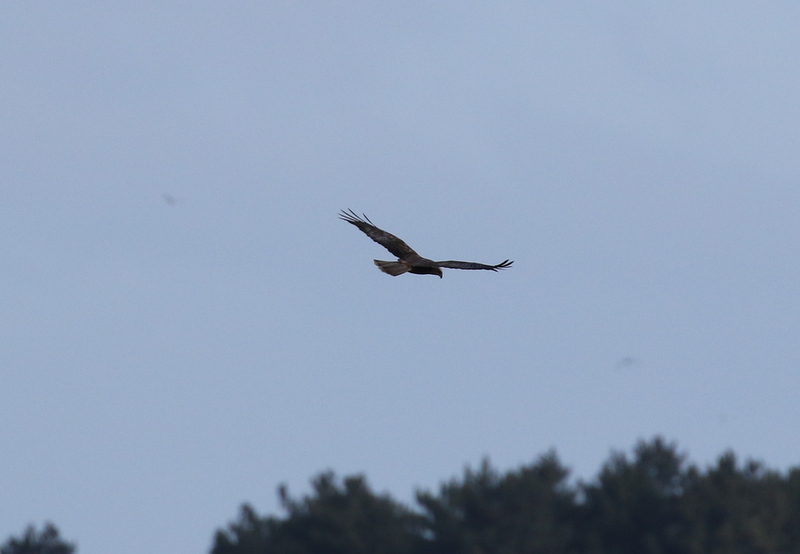 Marsh Harrier – lots of activity at Holkham this morning
Marsh Harrier – lots of activity at Holkham this morning
Our next stop was at Burnham Overy. As we set off across the fields to walk out to the seawall, lots of birds were singing – a Yellowhammer in the hedge, a Chiffchaff in the bushes and several Skylarks overhead. We could hear a Lesser Whitethroat too, but it was rather distant and drowned out by the Wrens singing in the foreground.
There are lots of Sedge Warblers in now, and we could hear several singing from the bushes either side of the path as we walked out, but they were proving hard to see well at first today. There was a cool NE breeze this morning, and they were all keeping down in the brambles. Eventually, one Sedge Warbler perched up nicely for a minute or two, so we could get a good look at it in the scope.
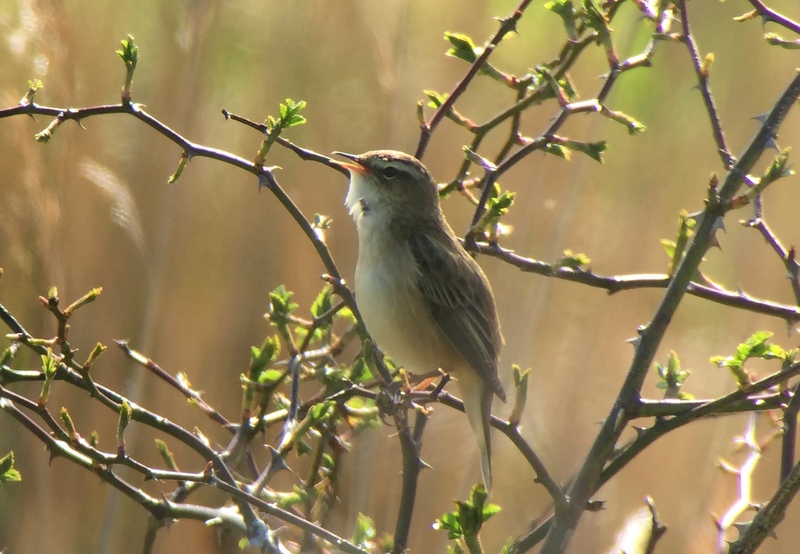 Sedge Warbler – there are lots back now and singing
Sedge Warbler – there are lots back now and singing
Most of the ducks and geese have left, but there were still a couple of Brent Geese on the grass – and a lot more out in the harbour on the saltmarsh, which they seem to prefer at this time of year. We managed to find a single drake Wigeon still, and a small number of Teal hiding in the grass around the edges of the pools, plus a few Shoveler and Gadwall. A lone Little Grebe was in one of the reedy channels.
There were plenty of Curlew, Redshank and Lapwing out on the grazing marshes. The latter two will stay to breed here and they are already starting to display, whereas the Curlew should be on their way north soon. From up on the seawall, the tide was out and we could see a few more waders out on the mud, including a few Grey Plover and Black-tailed Godwits, the latter mostly sporting varying amounts of bright rusty red breeding plumage on head and breast. A Greenshank called behind us and we turned to see it flying over the grazing marshes where we had just walked. It flew straight through and didn’t stop, on its way west.
Out at the reedbed, we could hear the Bittern booming. We stood and listened for a minute or so, also hoping that the Bearded Tits might put in an appearance, but it was probably too cold and windy this morning. One Willow Warbler flew past, hopping between the bushes as it made its way inland along the edge of the seawall, presumably a fresh migrant. Another Willow Warbler was singing from a hawthorn in the reedbed – not its usual habitat, so presumably it too would continue on its way soon.
We carried on along the seawall, heading for the dunes where we could get some shelter from the nagging cold breeze. Almost at the Boardwalk, a Whimbrel flew up from the saltmarsh calling, and disappeared off towards the dunes. There were lots of Meadow Pipits and Linnets from the seawall on the way out, and even more in the dunes. It is great to see so many of two declining species here.
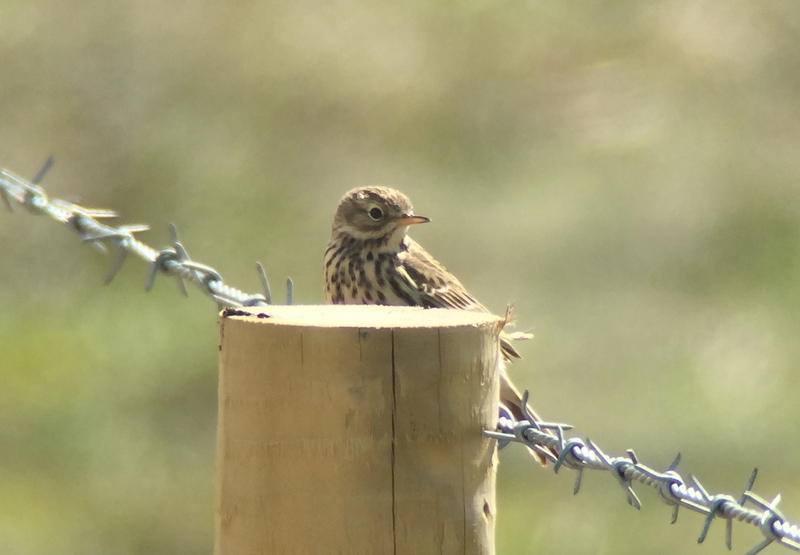 Meadow Pipit – they are still numerous in the dunes and grazing marshes
Meadow Pipit – they are still numerous in the dunes and grazing marshes
We turned east into the dunes and almost immediately flushed a couple of Grey Partridge. They flew across and landed on a marram-covered ridge a little further away, where we could get them in the scope. In a sheltered dune slack we then came across several Wheatear. A smart male was out on the short grass when we arrived but after a quick look through the scope he disappeared. It was quite disturbed in the dunes today, with lots of walkers, cyclists and dogs, which may be why they were more nervous than usual and kept mostly in the dunes behind the fence.
 Wheatear – a little shy today, here’s a recent photo
Wheatear – a little shy today, here’s a recent photo
Another local birder walking back the other way reported that there was no sign of any Ring Ouzels today, so we were very pleased when we found a group of them in the dunes. Like the Wheatears, they were very flighty today. We heard them first as they flew up over the dunes some distance before we got to them. It was hard to tell exactly how many there were, as they scattered in different directions, probably at least six.
We crept round to the other side of the dune in the hope of seeing them on the ground, but most of the Ring Ouzels had already disappeared. There were still at least two, which we followed for a while. They kept disappearing into the bushes and brambles. We didn’t want to keep flushing them, so we kept our distance, but still they wouldn’t really come out to feed, eventually flying out each time calling and across to another bush. A couple of times they did come out onto the grass briefly. In the end we left them to it.
 Ring Ouzel – very flighty today & mostly hiding in the bushes
Ring Ouzel – very flighty today & mostly hiding in the bushes
The bushes at the end of the pines were rather quiet today – another Lesser Whitethroat singing was the highlight. Probably the same Whimbrel we had seen flying this way earlier was feeding down on the grass beyond. There didn’t seem to be many migrants fresh in overnight, although once it started to warm up there was a constant trickle of Swallows moving west through the dunes. We made our way back.
Back at the reedbed, the Bittern was booming again. It sounded not too far in from the path, but we couldn’t see it in the reeds. We did hear Bearded Tits calling a couple of times and then glimpsed two of them as they zipped off low over the reeds and crashed back in out of sight.
While we were standing by the reeds, a bright white bird flew straight towards us high in the sky. We looked up to see a long white neck stretched out in front and long black legs trailing behind – a Spoonbill. As it came overhead, we even got a great view of its spoon-shaped bill!
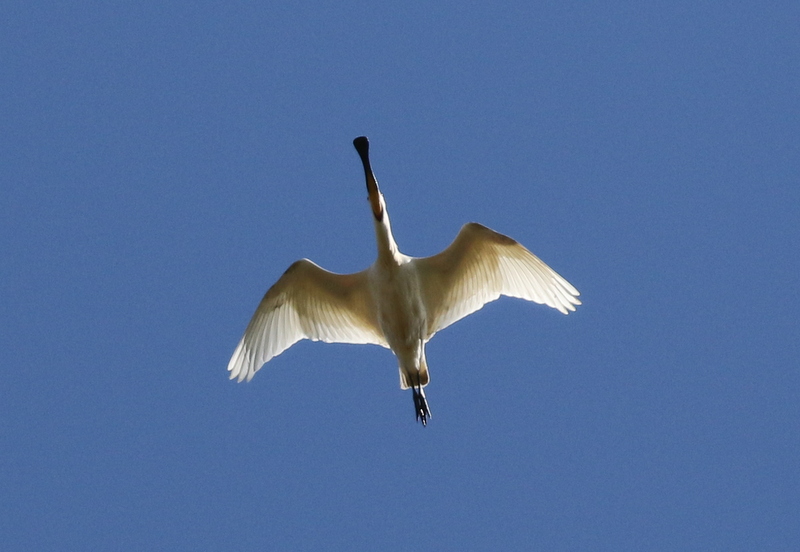 Spoonbill – check out the shape of that bill!
Spoonbill – check out the shape of that bill!
On the walk back across the fields, there were a couple more surprises in store. We looked off across the marshes to the east as all the waders and ducks scattered to see a Peregrine stooping down into them. It towered up and made another dive a couple of times without success, before losing interest and circling up high into the sky.
Then a Barn Owl appeared, most unexpectedly. They will fly during the day, but it is unusual to see them out at midday on a sunny spring day. Perhaps it had struggled to find food in the rain the last couple of days, perhaps it has a family to feed already, but whatever the reason it flew across to one of their favourite fields and started to fly round, hunting. We had great views of it in the sunshine. A couple of times it dropped down into the grass, but we didn’t see it catch anything.
 Barn Owl – out hunting in the middle of the day
Barn Owl – out hunting in the middle of the day
We had lunch at Holkham. A Goldcrest and a Coal Tit were singing from the holm oaks in the car park as we ate. A Swallow was zooming around the buildings. Then afterwards, we made our way east along the coast road to Stiffkey Fen.
As we got out of the car, we could see a male Marsh Harrier displaying, zooming back and forth over the reeds. Then a female circled up from below. The wind had dropped, the sun was out and it was starting to really warm up now. A couple of Common Buzzards circled up too, taking advantage of the warmth in the air, and the male Marsh Harrier seemed to take offense and had a quick swoop at them.
A Blackcap was singing from the trees and as we walked down the path by the river a Bullfinch flicked out of the hedge and flew off ahead of us calling. A Willow Warbler was singing from the willows, appropriately enough, and a Cetti’s Warbler shouted at us from the brambles.
As we got up onto the seawall, we could see a Greenshank feeding on the edge of the channel beyond. We just got the scope onto it when it flew a bit further along. A second Greenshank was a little further along, and a little later the two of them flew back together. There has been a Greenshank here all winter, but it was impossible to tell if these were both over-wintering birds or if one or other was a migrant just passing through.
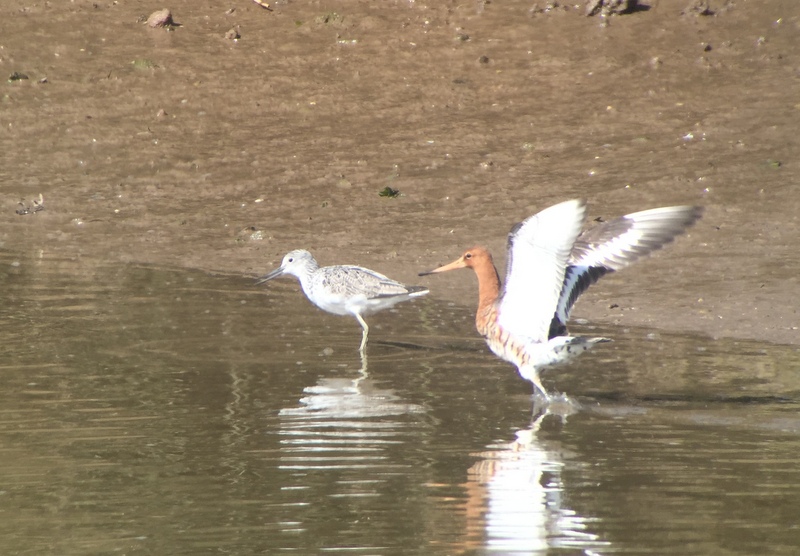 Greenshank – and Black-tailed Godwit in the harbour channel
Greenshank – and Black-tailed Godwit in the harbour channel
There was nothing particularly of note on the Fen itself today. Lots of Black-headed Gulls, several Avocets, a small group of roosting Black-tailed Godwits and a few other bits and pieces. So we continued on round towards the harbour. The tide was coming in and there were lots of Redshank and some smart summer-plumaged Black-tailed Godwits feeding in the channel.
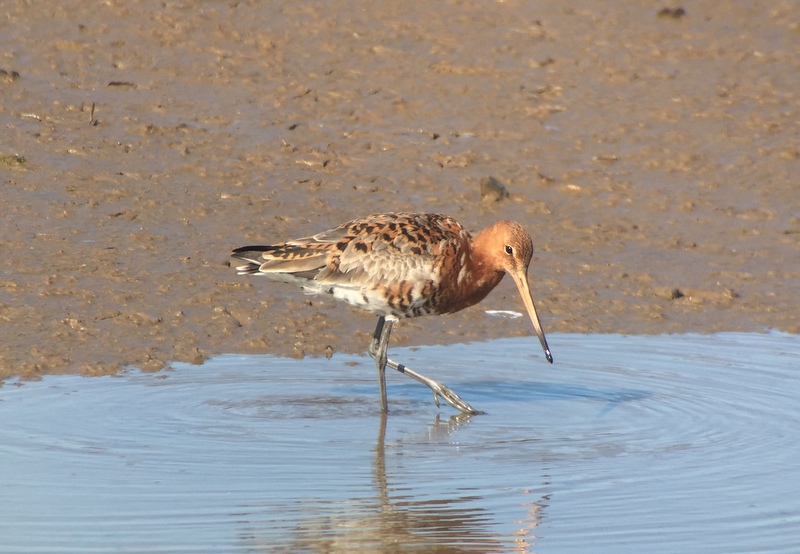 Black-tailed Godwit – now mostly in summer plumage
Black-tailed Godwit – now mostly in summer plumage
As we approached the harbour, a Kingfisher disappeared off out across the saltmarsh in a flash of electric blue, unfortunately too quick for most of the group to get onto. Thankfully it did a better flypast shortly after, when it came back the other way and flew off back towards the Fen. Out on Blakeney Point we could see lots of white shapes and through the scope we could just about see through the heat haze they were mostly Sandwich Terns. There were already over 1,000 counted last week, back for the breeding season.
The tide was rising now and the waders were gathered in flocks on the edge of the mud. Several Bar-tailed Godwits were on the end of a larger roosting flock of Oystercatchers. A Ringed Plover and a few Dunlin were picking about on one of the spits. As the water rose, a Grey Plover flew in and landed with a Dunlin, completely dwarfing it side-by-side on the mud. As all the waders were gradually pushed in by the tide, a large flock of Knot whirled round over the harbour.
While we were watching the waders, one of the group spotted a Goldeneye diving on the edge of the rising water. Then, nearby, a single female Red-breasted Merganser appeared too. At one point, the two of them were diving together. There were lots of Goldeneye and Red-breasted Mergansers in the harbour through the winter, but most have already departed north for the breeding season.
However, the highlight of our visit here was the Short-eared Owl which flew across the saltmarsh. It flew in from our left, and we caught sight of it as it approached. It flew across the channel right in front of us, its stiff-winged flight action a bit like rowing, before disappearing off towards Morston. It is always great to see a Short-eared Owl, but the light this afternoon on it was just perfect!
 Short-eared Owl – flew across the saltmarsh right in front of us
Short-eared Owl – flew across the saltmarsh right in front of us
It was magical down by the harbour in the sunshine this afternoon, listening to the sea beyond, watching the birds pushed in by the tide. In the end, we had to tear ourselves away and head for home.
 Blakeney Harbour – a glorious place to be in the sunshine this afternoon
Blakeney Harbour – a glorious place to be in the sunshine this afternoon
















